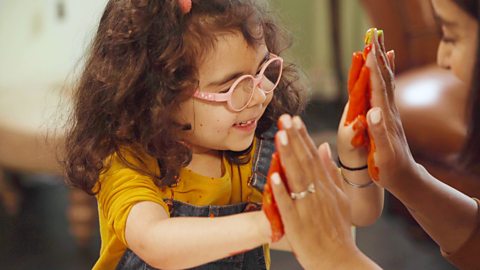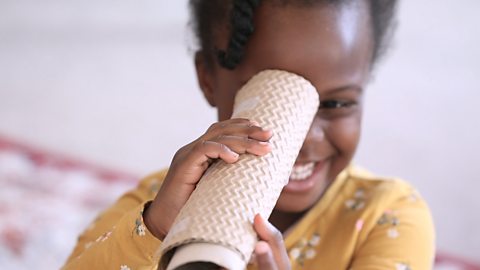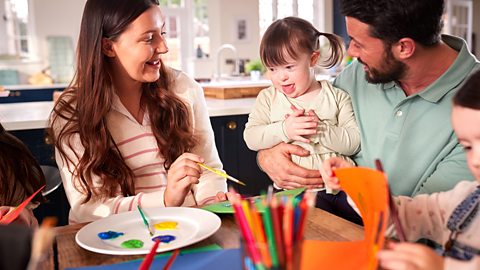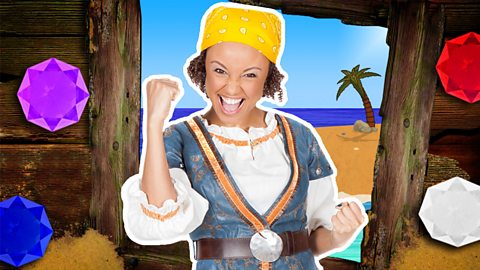Home > Tips and advice > Play
Not only are art and craft activities packed with sensory experiences to inspire your little one, but they are a fun and relaxed way to spend time together.
So as the conversation flows naturally over your painting, sticking or modelling (or whatever you happen to be doing), they're the perfect opportunity to introduce new words.
You donÔÇÖt need to be super artsy to get creative with your child and you shouldn't worry about creating beautiful artwork at the end of it all ÔÇô just focus on bonding and encouraging your little one. And be ready to get messy.
Children have lots of natural creativity, which is great if youÔÇÖre lost for ideas. Let them take the lead and decide what to do or make ÔÇôyou might be surprised with what they come up with.
Here are some simple ways to get crafty and chattyÔÇŽ

Find inspiration outdoors
Forget fancy art kits, Mother Nature can give you everything you need to get crafty together ÔÇô from making leaf collages to creating conker necklaces.
Being outside has lots of benefits for you and your little one and you can easily make creativity part of your outdoor time too ÔÇô giving you a chance to blow off the cobwebs and help your childÔÇÖs development too.
- Collect interesting items
Collect items from your garden or the park and make a mini garden on a paper plate. Take the time to chat through what things are called and help your child arrange them in an imaginative way.
- Look for different colours
Being outdoors is the perfect opportunity to start introducing your child to the words for different colours. If theyÔÇÖre older, children can point to them all and go on a treasure hunt. If itÔÇÖs safe to collect items, for example green grass and leaves, you can use these to make a messy collage or take pictures and draw them when youÔÇÖre back home.
- Talk about animals
Depending on their age, encourage your child to point at animals, try to name them or act out how they move. When you get home, ask them if they can remember what animals they saw and help them to draw one out for you. When they get older, your child can even start to make simple stories about animals they see.

Transform your recycling
As fun as it is to get outdoors, the great British weather isnÔÇÖt always welcoming, so you need a back-up plan. For these days, try getting creative with junk bits and bobs at home.
For example, something as simple as milk bottle tops can open up plenty of crafty possibilities; they can be used to help with counting, shape and colour recognition. You could even use them to make a tower or re-purpose them as mini paint pots.
- Talk about how things feel
Ask questions that get children feeling objects around them. Tell your child what things are made of (wood, plastic and so on) and ask them if they can guess from just the feel. They may be able to say the name or they can point to something else thatÔÇÖs made from the same thing.
- Sort things into colours together
A great activity for older children if you have a surplus of junk items from cereal boxes through to bottle tops. Once theyÔÇÖre sorted into coloured piles or even arranged into a rainbow, they can be used to make collages or cards for friends and family.
- Create characters
Transform things like old cardboard tubes, string and old sponges to create scrap people. Encourage your child to explain what they are doing at each step and talk about colours, textures and patterns. If your child is too young to be making something, you could create a puppet, put on a silly voice and get them giggling this way.

Try messy play
Arts and crafts are meant to be messy, so embrace it. Prepare an arty space by covering your floor or table with newspaper or old magazines (and have an cloth handy). Whether youÔÇÖre painting, playing with bubbles or baking ÔÇô itÔÇÖs great to get hands-on and talk about what youÔÇÖre doing. Messy play helps build your child's imagination and gives them confidence to use new words.
And if you're making something you're going to keep, let your child decide where to put it or who to give it to. It will make it an extra special memory as theyÔÇÖve had a say in where it goes.
- Explore textures
Creating your own texture book or board is a great idea for hands-on play. As they get stuck in, talk to your child about the sensations of different things, for example 'fluffy' cotton wool and 'crunchy' tin foil.
- Make noise
Whether youÔÇÖre crunching leaves or splashing water, make messy play noisy too. Even babies can get involved: they love the sound of ripping paper, so why not wrap an item up for them and help them to rip it?
- Set up and tidy up together
Once youÔÇÖve got messy a few times, your child will start to learn the drill. They'll know to put old magazines down first and that they need to wear an apron. Find out what your child remembers (youÔÇÖll be surprised!) by asking them whatÔÇÖs needed. This way they will really feel part of the activity and will start chatting with you straight away.
You child can help with the clearing up too (even if that means it takes a little longer) ÔÇô itÔÇÖs another great chance to interact and chat about what needs to happen.
Important safety advice
Keep an eye on your child at all times during craft activities and playtime. And remember to keep small and sharp objects out of their reach.
if you're touching plants, please be aware that some are potentially harmful. Check out .






